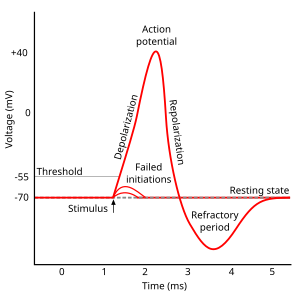Afterhyperpolarization
AHPs have been segregated into "fast", "medium", and "slow" components that appear to have distinct ionic mechanisms and durations.
During single action potentials, transient depolarization of the membrane opens more voltage-gated K+ channels than are open in the resting state, many of which do not close immediately when the membrane returns to its normal resting voltage.
Hence, hyperpolarization persists until the membrane K+ permeability returns to its usual value.
[5][6] The afterhyperpolarized (sAHP) state can be followed by an afterdepolarized state (which is not to be confused with the cardiac afterdepolarization) and can thus set the phase of the subthreshold oscillation of the membrane potential, as reported for the stellate cells of the entorhinal cortex.
[7] This mechanism is proposed to be functionally important to maintain the spiking of these neurons at a defined phase of the theta cycle, that, in turn, is thought to contribute to encoding of new memories by the medial temporal lobe of the brain [8]
